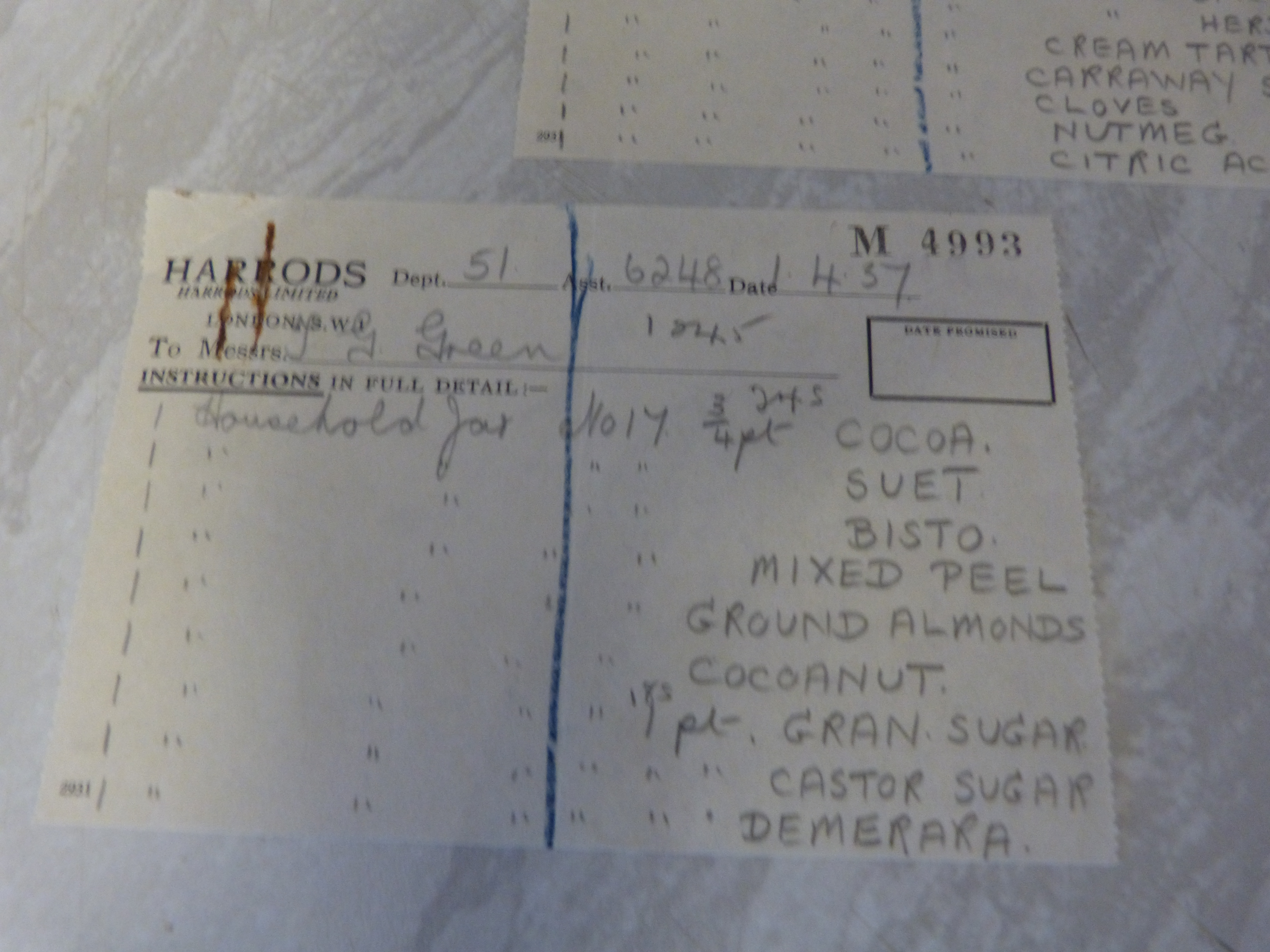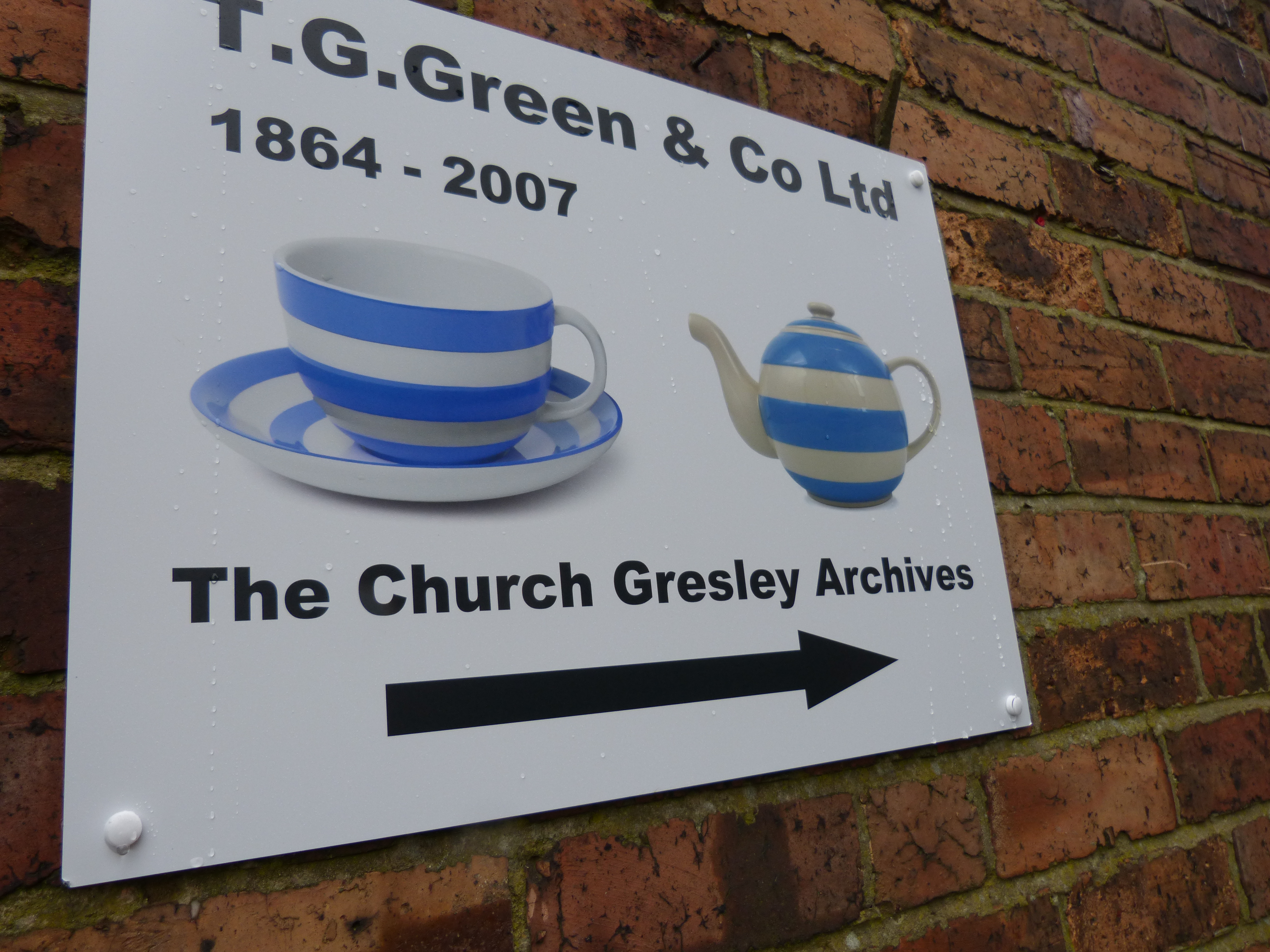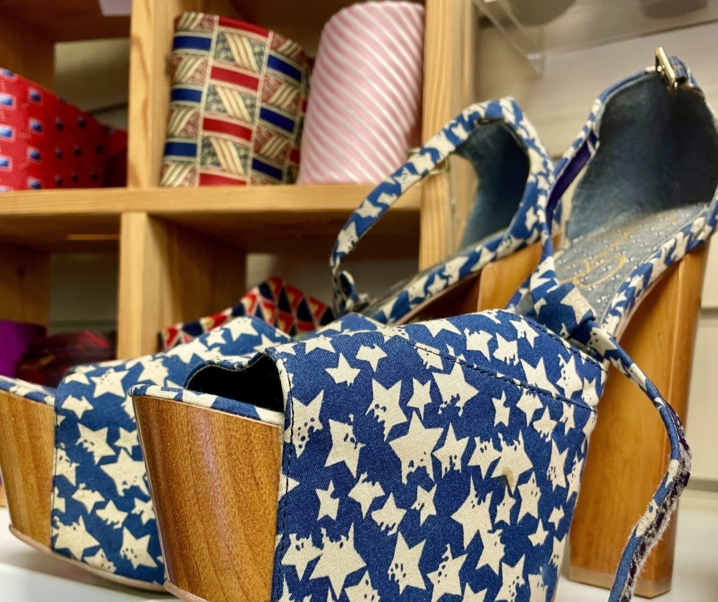Imagine the feeling some people get on being shown into a garage of performance cars or a walk-in wardrobe stuffed with designer frocks and shoes. It’s an overwhelming feeling of excitement that comes from being in the same space as something you desire, worship, covet and adore.

It’s the feeling I experienced on being shown the Cornishware collection of Dr Iain Hambling at the museum and archive he has created on Church Road in Church Gresley – just a gentle stroll down from the former TG Green pottery.
Every shelf and surface, cubby hole and counter top, nook and cranny is stuffed with the cream of TG Green Cornishware. Small wonder the distinctive electric or e-blue and cream banded pottery has been the favourite of housekeepers, housewives, hippies, Hooray Henrys and now hipsters since its launch in 1923; it is breath-taking.


Iain, archivist and historian, has one of the most comprehensive private collections (2750 pieces and counting) of TG Green pottery in the world. My eyes are practically on stalks. I knew Cornishware pots and jars were often labelled with store cupboard staples like tea, coffee, sugar, sultanas and raisins but I didn’t know people could personalise, through shopkeepers, their own jars. These commissions account for some incredibly rare items; like Iain’s mis-spelt ‘cocoa-nut’ jar and the ‘Parsley Seasoning’ which he bought for a record £1,200.
“You could buy the standard jars at the store but you’d have to order other items,” Iain explains pointing out a rare jar designed to contain Trex vegetable fat.
‘Your 1930s housewife would look in a catalogue in, say, Harrods. She’d fill in a chitty saying what she wanted – say desiccated coconut or angelica – and this order would come up to Church Gresley so the plain jar could be lettered. Which accounts for some of the spelling mistakes. Imagine our housewife wanted a jar for caster sugar. This would be done by someone who’d been educated in the local village school who would know it as the medicine a matron would give to a child. Hence I have a jar with the spelling ‘castor’ sugar like the oil.”

Although the fortunes of the original TG Green company in Church Gresley dipped and eventually foundered; Cornishware has retained its popularity and – as the centenary of its launch approaches – it is still in production under the TG Green banner at a pottery in Somerset.
A fine legacy for its founder Mr Frederick Parker, whose picture is pinned to the kitchen wall at the museum; “He came from the potteries in Stoke and started at TG Green as work’s general manager,” Iain explains.
“He was working on perfecting the banding technique from 1919 – that’s the way you take a plain white jug, dip with a electric or e-blue colour slip and then remove a band of colour to reveal the white stripes using a lathe. He tried this technique using all types of local clay but with little success until he came to use Cornish China Clay, hence the name.”

Iain says that, after the war, the advertising department came up with a more ‘romantic’ version. “There is a popular story that a salesman called Mr Fanshawe came up with the pattern after visiting Cornwall. He was said to be inspired by the blue of the sea topped by the white caps of the waves and the blue of the sky against a line of white cloud. Sadly, this doesn’t stack up. When the first set of seven graduated Cornishware jugs were put on sale, Fanshawe would have been 15 years old.”
The factory made a huge amount of tableware but Cornishware remained the most consistent seller; “It’s hard to imagine what a big concern the factory was in Church Gresley. There’s saying that this village was ‘pits, pots and pipes’ in terms of where people worked,” Iain laughs.
“The factory once employed a thousand people and they were making thousands of pieces – some of which were personalised for birthdays etc and smuggled out of the factory under the ladies’s coats. So it’s surprising that the antique and vintage shops in Derbyshire aren’t full of Cornishware.”

This scarcity of old Cornishware is something I can confirm. I have been scouring Derbyshire shops, markets and fairs for vintage pieces and finally thought I had come up trumps at an auction house selling one of the traditional ‘dreadnought’ jugs. The piece wasn’t dated in the catalogue but I assumed it was old. On getting my piece home, I noticed a disturbing phrase on the bottom (back) stamp.
“Ah yes, dishwasher proof – always a give-away,” Iain smiles.
“Much like the many enquiries I get each week about Cornishware with the old black shield to the base. People often think they’ve found a really rare piece, until I point out the bottom banner that now says tgreen.co.uk – find me another website address in the 1930’s. Still it’s a nice piece and it’s good that you’re using it.”
Ian own collection of TG Green, which runs into thousands, began with a humble egg cup he still owns.
“I was a junior doctor on the obstetrics and gynaecology ward at Forest Gate Maternity Hospital in East London. It was 2pm and I’d walked to the Ilford Market and picked up a little Cornish ware egg cup from a shelf on a stall. I don’t know if I was homesick and it reminded me of my childhood but I bought it despite living in a 1990s minimalist flat. But I loved the fact that this old piece looked modern and fresh.”

From that small egg cup, Iain was hooked; “From that point on I went round all the markets in Greenwich, Camden and Deptford buying TG Green pottery. By 1996, I was at Bristol Royal Infirmary and went into a shop to buy a jar labelled ‘Cherries’ but the lady, who was on a step-ladder, dropped it and it smashed. She promised to ring if any more came in. A few days later the phone did ring but it wasn’t the lady from the shop – she’s passed my number on to Paul Atterbury of the Antiques Roadshow.”

Paul asked to see his collection of Cornishware; “I presumed it was a joke until a well-spoken gentleman appeared at my door with his trademark grey hair and long dark coat. It turned out he was writing a book on Cornishware and asked if he could borrow my collection to photograph. I contributed to two books on Cornishware in 1996 and 2001.”
Iain admits his collection has not been cheap to collate. “It was relatively expensive in the 1920s and it’s still expensive,” he says.
“Because so many of the early pieces were ‘one offs’, it’s not unusual for me to bid up to £1,000 for something which plugs a gap in my collection. I’m often bidding against known collectors. George, a collector from Tasmania, contacted me to say we’d been rival bidders for too long and invited me to visit him. He had so much, some of the TG Green pieces were still in packing cases and containers. Another lady collector from Colchester wants own a piece of everything TG Green ever produced. That could take a lifetime but that’s how passionate TG collectors are about this pottery.”


Iain’s 27-year long enthusiasm for TG Green pottery remains undiminished. The ‘hobby’ sees him rushing from his job at a secondary school to open up the museum and and weekends can be taken up by talks on the subject – often at the nearby Sharpe’s Pottery Museum in Swadlincote. And he is desperate for more.
Given enough time and heritage funding, Iain would like to extend the museum into the empty storeroom/shop below the two floors he currently leases in Church Gresley.
“My dream would be to have a little cafe run by old employees who could talk to people about the history of the company. It would put the heart and soul back into the village.”
On the way out, I cannot resist another look into another little room stuffed with photographs and letters. It’s here Iain shows me one of his most prized TG Green possessions. A TG Green product description for a brand new novelty item toothbrush holders complete with pencil drawings – along with one of the pieces.

“I have the Dutch boy but can you imagine how much I would love to find the girl. She out there somewhere…”
TG Green enthusiast – Emma Fox, designer/maker of jewellery, from Surrey

 “I found them in a charity shop about 15 years ago in Reigate, I just love the simplicity of the design,” says Emma.
“I found them in a charity shop about 15 years ago in Reigate, I just love the simplicity of the design,” says Emma.
“I almost skipped out of the shop.”
According to Dr Iain Hambling, the green shield (left) reveals the pieces to date from the 1960s. “It is a perfect back stamp for the yellow. Yellow was made in 1959 with the Green Shield back stamp. It was first displayed at a Trade Show in Blackpool in February 1960 and advertised in April of the same year.”

A potted history of TG Green of Church Gresley
TG Green is named after its founder Thomas Goodwin Green or ‘Swearing Tom’. Legend has it that Tom bought the factory in while on honeymoon in Scarborough with his wife Mary Tenniel – sister of John, the illustrator of Alice in Wonderland. The truth is that he met factory owner Henry Wileman and, impressed by the man who’d made a fortune in the building trade in Australia, Henry offered Thomas a managerial role at the small village pottery. Thomas eventually bought the company – with the help of his sister – and changed the company name in 1864.


After the initial success with Cornishware, the design barely changes for 40 years. In 1968, a young designer called Judith Onions is brought in to modernise the shape and design – and change the logo on the bottom
Usually associated with e-blue and cream, Cornishware has been produced in other several colours according to Lucy and Pete Ferrary, enthusiasts who run Cornishware Biz. Over the years of collecting, and selling, Peter and Lucy have collected every variation of Cornishware including yellow and white which first appeared in the 1959, possibly to complement the fashion for melamine table tops.
Other variations:-
- green and white
- red and white (extremely collectible)
- gold and white (not as popular with collectors although the early version, with the shield, is more desirable)
- all white
- black and white
- tangerine and white
- navy and white (commissioned exclusively for Terence Conran’s Habitat store in the 1970s and later for Marks and Spencer
- lime and white
- plum and white (very rare as it was made in 2004 as a Christmas present for Mason and Cash employees)
- baby pink/blue
- gold and blue – a combination which has been seen by Pete and Lucy once – on a sugar bowl – ten years ago.

After Thomas dies in 1905, the company passes to his son Roger and associate Henry Green. The Green and King families continue to run the business until 1964. With no children to succeed ‘Mr Kenneth’ Green, the company passes into the hands of the Jersey Banking Corporation. In 1972, the corporation approach the South Derbyshire District Council to knock down the old brick kilns to ease movement around the site. The council say refuses. “The company decide to burn all the paperwork; all the deeds, design booklets,” explains TG Green archivist and historian Dr Iain Hambling. “It seems their attitude was, if you won’t let us go forward, you’re not going to have the past.”

In the 1980s, TG Green passes into the hands of Swindon-based Cloverleaf pottery. Sadly, cheap imports affect sales and the firm is sold to Mason and Cash in 2001 – an adjacent company famous for mixing bowls. But the relationships between the firms was anything but friendly.
“I think the theory was to merge the factories together by taking down the wall between them but the old rivalries ran very deep and it was a headache from the word go,” says Iain.

“When John Perks, MD of Mason and Cash sold the company to The Tabletop Group, from Sutton-in-Ashfield, in 2004 I think he was more than ready to call it a day.”
The financial crash of 2007 sees rumours starting to circulate about TG Green’s future. “I heard the stock-piles went into the ceiling but the staff levels had been reduced to around 300 and I couldn’t help wondering what was about to happen,” Iain recalls.
“In June 2007, the management told the staff to leave at 3.30pm, saying there would be an announcement at the start of the shift the next morning. By the time the staff arrived, the doors were padlocked. The firm had gone into liquidation. When the official receivers finally got into the factory everything had been removed including pottery stock, equipment and paperwork. One of the previous employees if quoted as saying the closure has ‘taken the life out of Church Gresley’.
After a brief stint when it was manufactured in China, the company was bought by ‘life-long admirers’ Charles Rickards and Paul Burston. The duo teamed up with designer and brand consultant, Perry Haydn Taylor, whose wife Vik is a collector.

Cornishware is now made in Somerset and, in addition to reviving the traditional designs, the company has launched new products lines including linen oven gloves and aprons. The wheel has come full circle as you can once again, for the reasonable sum of £5, personalise your jars and mugs.

Sadly, the original pottery building has seen no such revival in fortunes. The land around the factory has been purchased by a local businessman and the factory site itself is strictly off-limits to the public. Iain is one of the few – other than urban photographers who enter abandoned buildings without permission – who has been allowed to photograph the site.
“I could see through the windows that it’s still full of papers, moulds and tools. It’s still a beautiful but mostly derelict building,” Iain says.
TG Green enthusiast Victoria Chapman, of Hampshire, who runs an eponymous lifestyle blog.

“I never thought at the age of 28 I’d be getting quite so excited over crockery,” says Victoria.
“But I just love the classic look of Cornishware. It’s simple, yet really stylish. One of my favourite sets of TG Green items are my mugs. I really, really love these mugs and I use them all the time. I’m super paranoid that I might drop one and the set won’t match any more, which will be really annoying. But no point worrying about that until it actually happens.”
Fancy owning a piece of history?
The good news, according to Dr Iain Hambling, is that it’s a good time to collect vintage TG Green Cornishware. The bad news is that prices are being depressed by the number of fakes on the market.

“Faking Cornishware goes back to the 1990’s when it first became really collectable, fakers realised that adding names and back stamps to blank jars could earn them easy money,” says Iain.

“Early faked jars were often crude with acrylic glazes. As time moves on and the rise of home/community pottery rises in popularity more competent glazes have been found making faked Cornishware jars harder to detect.”
Even Iain has been fooled. He viewed a beef suet jar with such precise letter – and stamp – he was 99.9 per cent sure it was genuine. However, when the owner of the jar started to list other jars bearing lettering saying ‘Horlicks’ and ‘Chickpeas’, Iain became 99.9 per cent sure they were dubious.
“Firstly, it is agreed that Chickpeas simply were not available in the 1930’s/1950’s and Horlicks always came in airtight glass jars and so decanting it into a jar with a loose lid would have been ludicrous.,” he explains.
“We are clearly entering a new phase in fake jars. The advice is to proceed with caution if you are parting with large amounts of money, it really has become buyer beware. Buying from reputable collectors maybe the best way to go… when so many jars now come from individuals via eBay, alarm bells really do begin to ring.”
Iain shows me a jar which one of this visitors sent to him. It looks authentic enough until Iain points to the letters which are peeling away from the jar.
“The jar itself is worth around £10 with no lettering, but £600 with something rare on the front – that’s why there are so many fakes on the market.”

It is worth the search. Plain pieces and mass produced ‘labels’ can be yours for £10-30. But you’ve hit the jackpot if you can find one with rare lettering; usually foodstuffs we don’t use today. Look out for; Acdo, arrowroot, Atora, Bisto, boracic crystals, camomile, cayenne, fish dripping, gelatine, treacle and vermicelli.
But set a limit if you are bidding on an auction site. If something comes onto the market, which hasn’t been seen before, collectors will often send prices sky-high. Condition and rarity are all-important. Rare colours – which were produced sporadically – are also hugely collectible.












